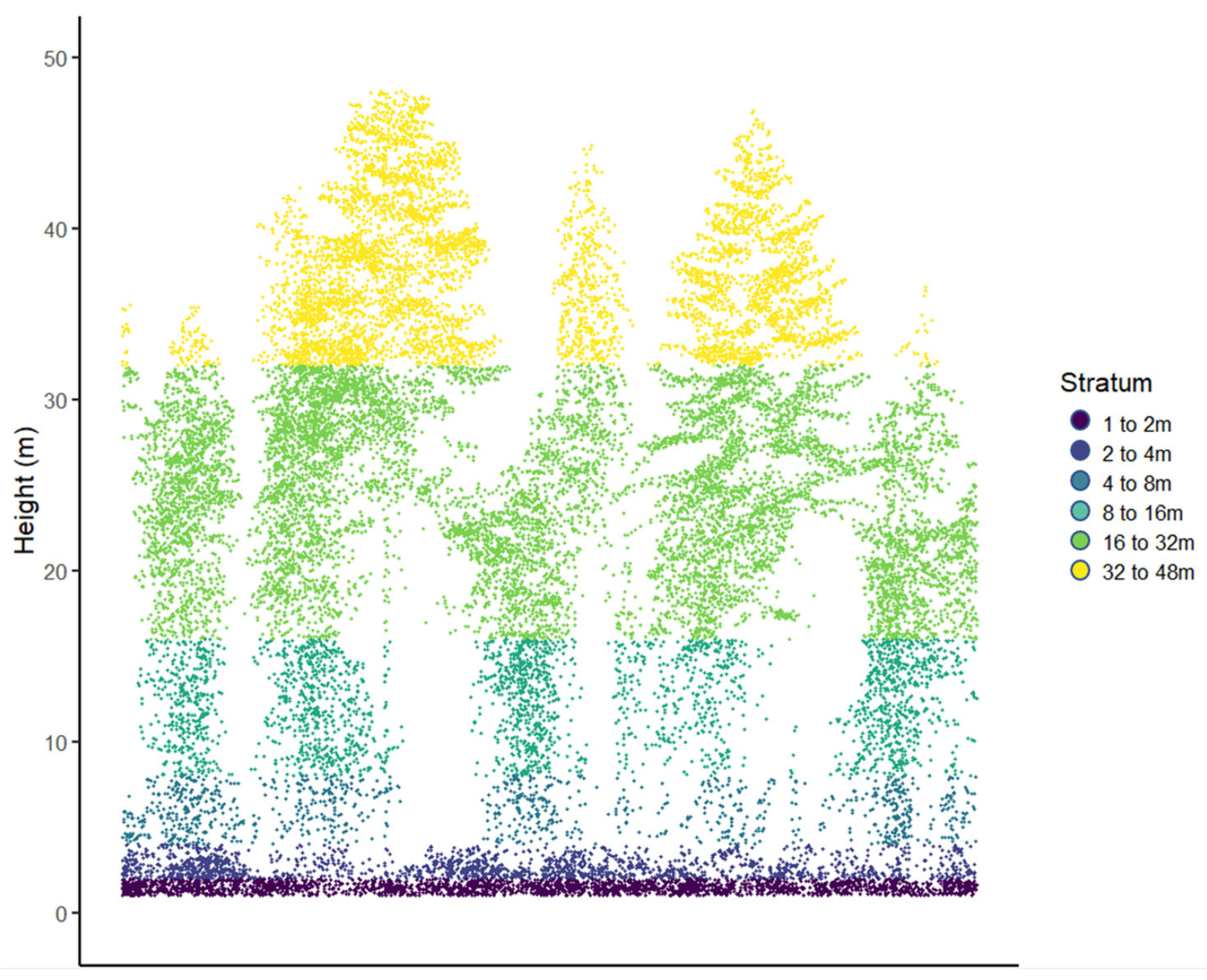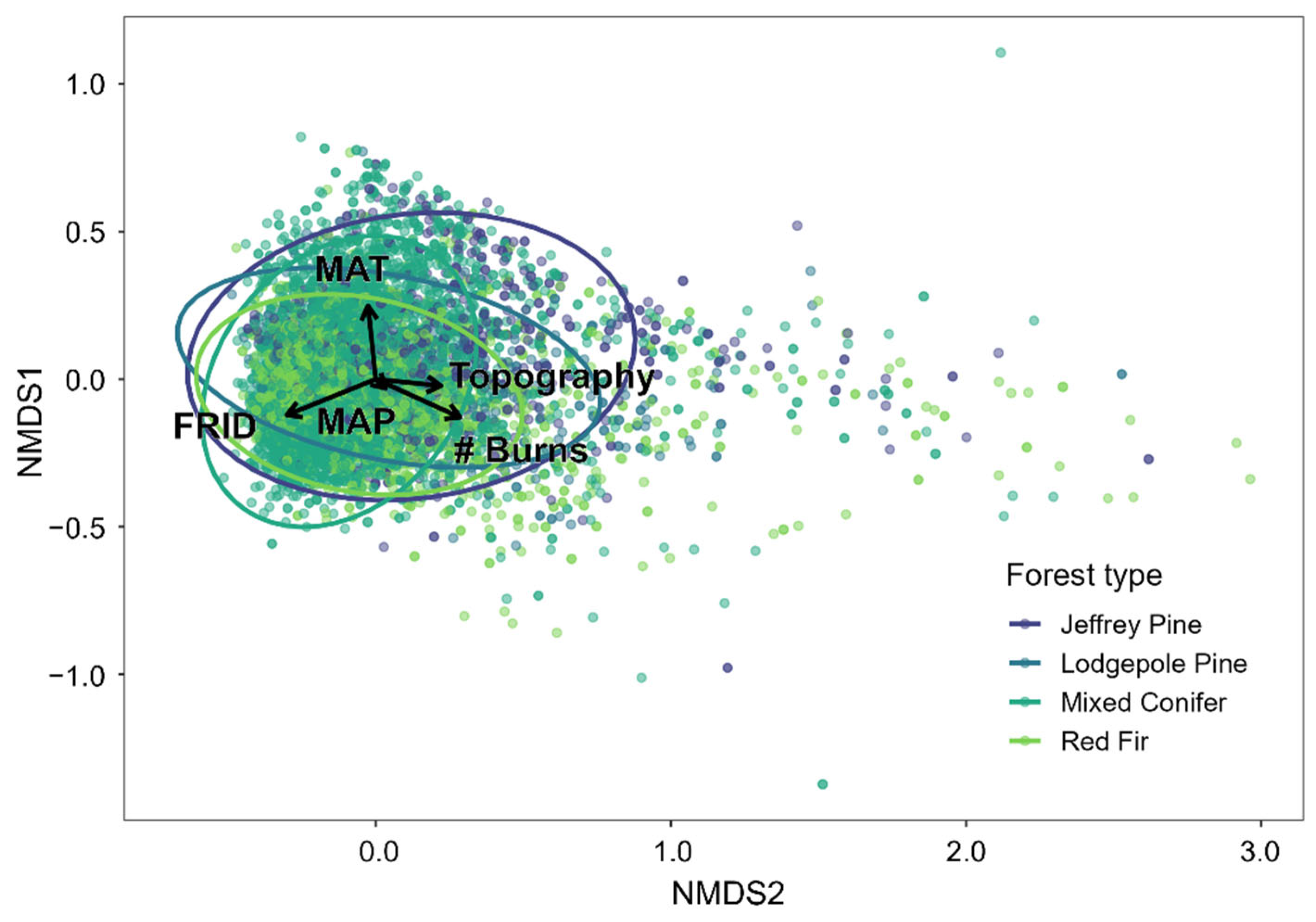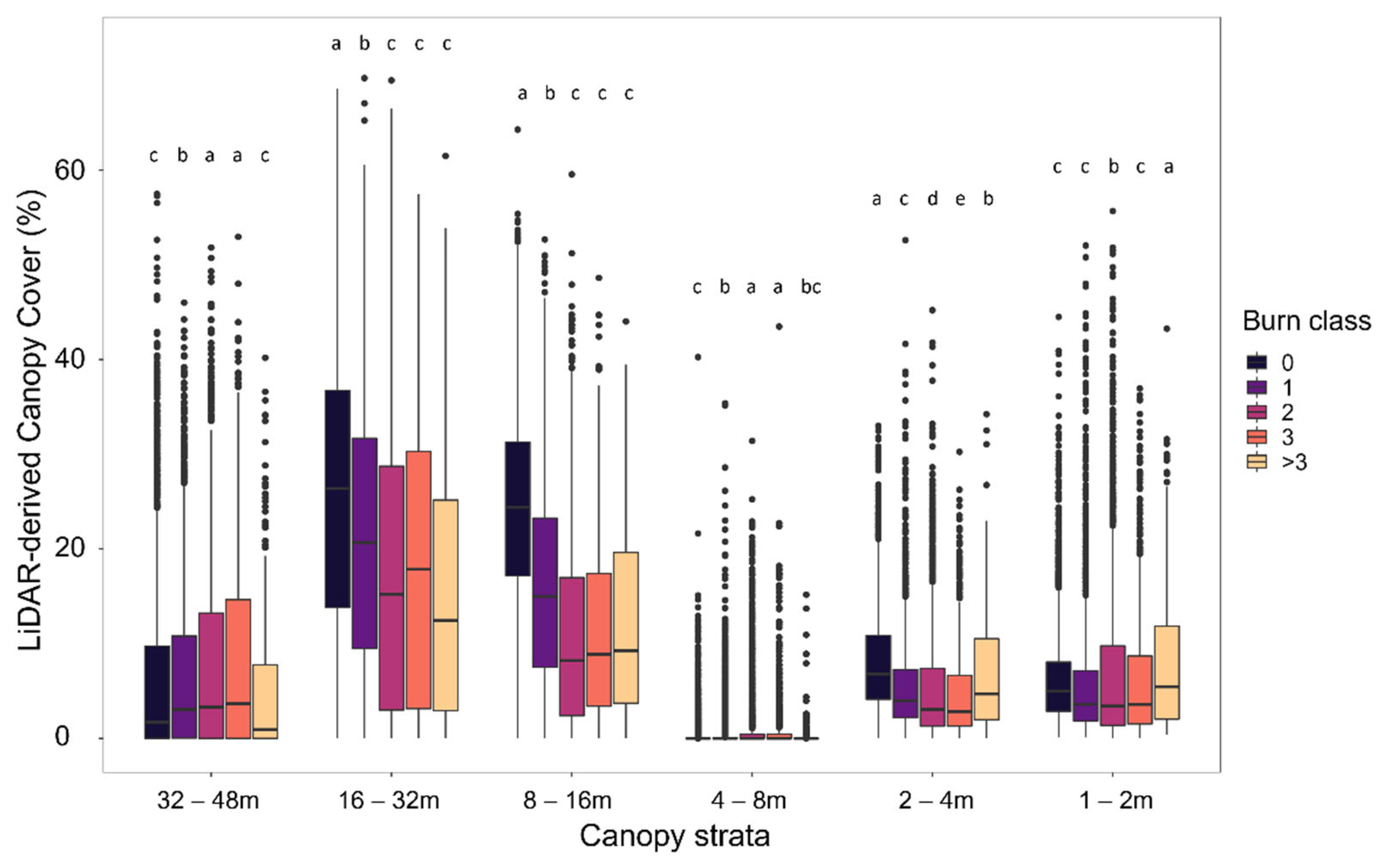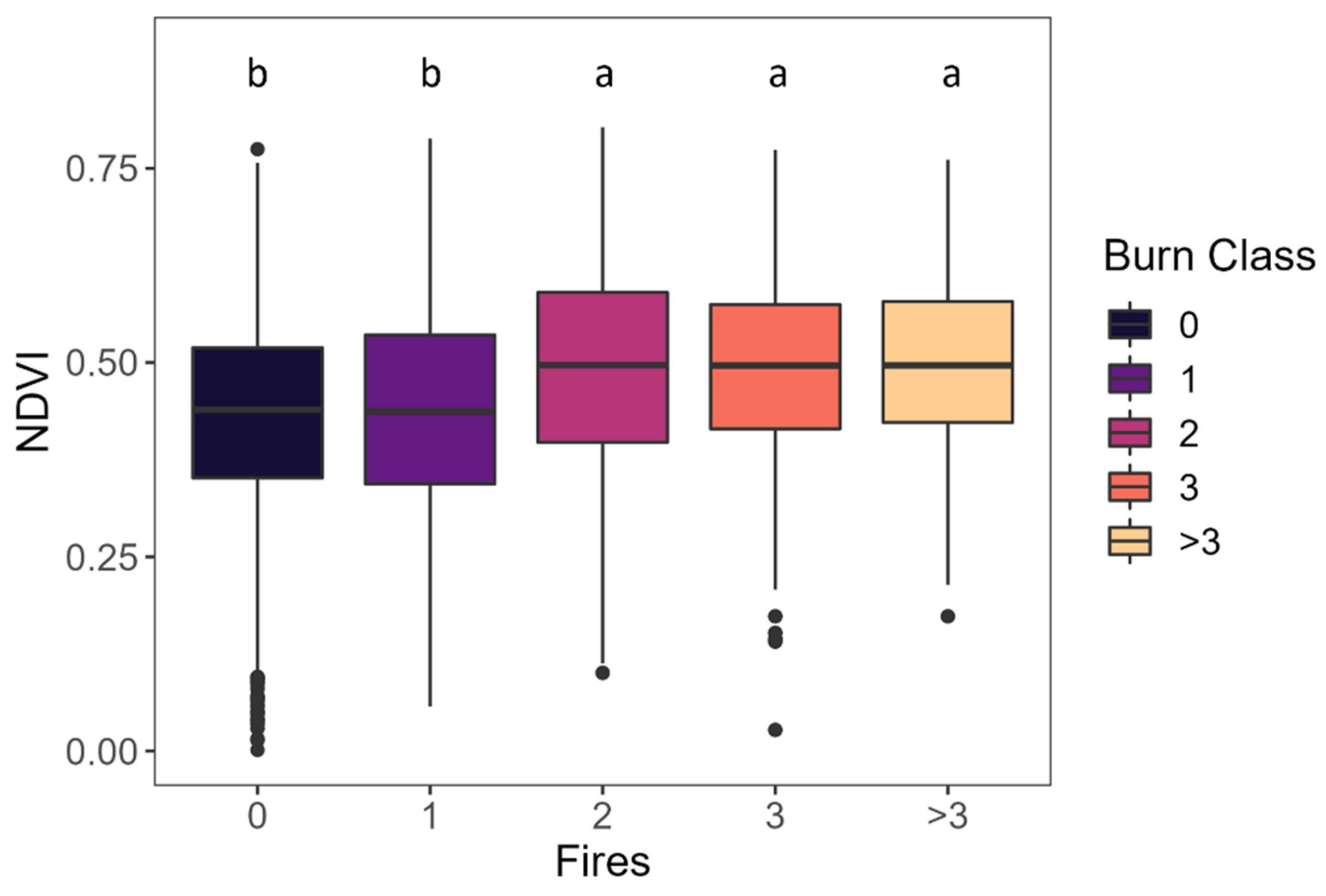Second-Entry Burns Reduce Mid-Canopy Fuels and Create Resilient Forest Structure in Yosemite National Park, California
Abstract
:1. Introduction
2. Materials and Methods
2.1. Study Area
2.2. Data Sources
2.3. Statistical Analyses
3. Results
3.1. Drivers of Forest Structure
3.2. Fire-Mediated Forest Conditions
4. Discussion
5. Conclusions
Supplementary Materials
Author Contributions
Funding
Data Availability Statement
Acknowledgments
Conflicts of Interest
References
- White, P.S. Pattern, Process, and Natural Disturbance in Vegetation. Bot. Rev. 1979, 45, 123. [Google Scholar] [CrossRef]
- Agee, J.K. The Landscape Ecology Western Forest Fire Regimes. Northwest Sci. 1998, 72, 24–34. [Google Scholar]
- Bond, W.J.; Keeley, J.E. Fire as a Global “Herbivore”: The Ecology and Evolution of Flammable Ecosystems. Trends Ecol. Evol. 2005, 20, 387–394. [Google Scholar] [CrossRef] [PubMed]
- Turner, M.G. Landscape Ecology: The Effect of Pattern on Process. Annu. Rev. Ecol. Syst. 1989, 20, 27. [Google Scholar] [CrossRef]
- Collins, B.M.; Miller, J.D.; Thode, A.E.; Kelly, M.; van Wagtendonk, J.W.; Stephens, S.L. Interactions Among Wildland Fires in a Long-Established Sierra Nevada Natural Fire Area. Ecosystems 2009, 12, 114–128. [Google Scholar] [CrossRef]
- Parks, S.A.; Holsinger, L.M.; Miller, C.; Nelson, C.R. Wildland Fire as a Self-Regulating Mechanism: The Role of Previous Burns and Weather in Limiting Fire Progression. Ecol. Appl. 2015, 25, 1478–1492. [Google Scholar] [CrossRef]
- Mistry, J.; Berardi, A.; Andrade, V.; Krahô, T.; Krahô, P.; Leonardos, O. Indigenous Fire Management in the Cerrado of Brazil: The Case of the Krahô of Tocantíns. Hum. Ecol. 2005, 33, 365–386. [Google Scholar] [CrossRef]
- Anderson, M.K. The Use of Fire by Native Americans in California. In Fire in California’s Ecosystems; Sugihara, N., Ed.; University of California Press: Berkeley, CA, USA, 2006; pp. 417–430. ISBN 978-0-520-24605-8. [Google Scholar]
- Lake, F.K.; Christianson, A. Indigenous Fire Stewardship. In Encyclopedia of Wildfire and Wildland-Urban Interface Fires; Springer Nature: Cham, Switzerland, 2019. [Google Scholar]
- Hoffman, K.M.; Davis, E.L.; Wickham, S.B.; Schang, K.; Johnson, A.; Larking, T.; Lauriault, P.N.; Quynh Le, N.; Swerdfager, E.; Trant, A.J. Conservation of Earth’s Biodiversity Is Embedded in Indigenous Fire Stewardship. Proc. Natl. Acad. Sci. USA 2021, 118, e2105073118. [Google Scholar] [CrossRef]
- Donovan, G.H.; Brown, T.C. Be Careful What You Wish for: The Legacy of Smokey Bear. Front. Ecol. Environ. 2007, 5, 73–79. [Google Scholar] [CrossRef]
- Abatzoglou, J.T.; Williams, A.P. Impact of Anthropogenic Climate Change on Wildfire across Western US Forests. Proc. Natl. Acad. Sci. USA 2016, 113, 11770–11775. [Google Scholar] [CrossRef]
- Doerr, S.H.; Santín, C. Global Trends in Wildfire and Its Impacts: Perceptions versus Realities in a Changing World. Philos. Trans. R. Soc. Lond. B Biol. Sci. 2016, 371, 20150345. [Google Scholar] [CrossRef] [PubMed]
- Stevens-Rumann, C.S.; Kemp, K.B.; Higuera, P.E.; Harvey, B.J.; Rother, M.T.; Donato, D.C.; Morgan, P.; Veblen, T.T. Evidence for Declining Forest Resilience to Wildfires under Climate Change. Ecol. Lett. 2017, 21, 243–252. [Google Scholar] [CrossRef] [PubMed]
- Hagmann, R.K.; Hessburg, P.F.; Salter, R.B.; Merschel, A.G.; Reilly, M.J. Contemporary Wildfires Further Degrade Resistance and Resilience of Fire-Excluded Forests. For. Ecol. Manag. 2022, 506, 119975. [Google Scholar] [CrossRef]
- North, M.P.; Stephens, S.L.; Collins, B.M.; Agee, J.K.; Aplet, G.; Franklin, J.F.; Fulé, P.Z. Reform Forest Fire Management. Science 2015, 349, 1280–1281. [Google Scholar] [CrossRef]
- Collins, B.M.; Fry, D.L.; Lydersen, J.M.; Everett, R.; Stephens, S.L. Impacts of Different Land Management Histories on Forest Change. Ecol. Appl. 2017, 27, 2475–2486. [Google Scholar] [CrossRef]
- Van Wagtendonk, J.W. The History and Evolution of Wildland Fire Use. Fire Ecol. 2007, 3, 3–17. [Google Scholar] [CrossRef]
- Taylor, A.H.; Skinner, C.N. Spatial patterns and controls on historical fire regimes and forest structure in the Klamath Mountains. Ecol. Appl. 2003, 13, 704–719. [Google Scholar] [CrossRef]
- Kane, V.R.; North, M.P.; Lutz, J.A.; Churchill, D.J.; Roberts, S.L.; Smith, D.F.; McGaughey, R.J.; Kane, J.T.; Brooks, M.L. Assessing Fire Effects on Forest Spatial Structure Using a Fusion of Landsat and Airborne LiDAR Data in Yosemite National Park. Remote Sens. Environ. 2014, 151, 89–101. [Google Scholar] [CrossRef]
- Dolanc, C.R.; Safford, H.D.; Thorne, J.H.; Dobrowski, S.Z. Changing Forest Structure across the Landscape of the Sierra Nevada, CA, USA, since the 1930s. Ecosphere 2014, 5, art101. [Google Scholar] [CrossRef]
- Collins, B.M.; Everett, R.G.; Stephens, S.L. Impacts of Fire Exclusion and Recent Managed Fire on Forest Structure in Old Growth Sierra Nevada Mixed-Conifer Forests. Ecosphere 2011, 2, art51. [Google Scholar] [CrossRef]
- Lutz, J.A.; van Wagtendonk, J.W.; Franklin, J.F. Twentieth-Century Decline of Large-Diameter Trees in Yosemite National Park, California, USA. For. Ecol. Manag. 2009, 257, 2296–2307. [Google Scholar] [CrossRef]
- Stephens, S.L.; Lydersen, J.M.; Collins, B.M.; Fry, D.L.; Meyer, M.D. Historical and Current Landscape-Scale Ponderosa Pine and Mixed Conifer Forest Structure in the Southern Sierra Nevada. Ecosphere 2015, 6, art79. [Google Scholar] [CrossRef]
- Miller, C.; Urban, D.L. Forest Pattern, Fire, and Climatic Change in the Sierra Nevada. Ecosystems 1999, 2, 76–87. [Google Scholar] [CrossRef]
- Collins, B.M.; Kelly, M.; van Wagtendonk, J.W.; Stephens, S.L. Spatial Patterns of Large Natural Fires in Sierra Nevada Wilderness Areas. Landsc. Ecol 2007, 22, 545–557. [Google Scholar] [CrossRef]
- Scholl, A.E.; Taylor, A.H. Fire Regimes, Forest Change, and Self-Organization in an Old-Growth Mixed-Conifer Forest, Yosemite National Park, USA. Ecol. Appl. 2010, 20, 362–380. [Google Scholar] [CrossRef]
- Agee, J.K.; Skinner, C.N. Basic Principles of Forest Fuel Reduction Treatments. For. Ecol. Manag. 2005, 211, 83–96. [Google Scholar] [CrossRef]
- Stephens, S.L.; Moghaddas, J.J.; Edminster, C.; Fiedler, C.E.; Haase, S.; Harrington, M.; Keeley, J.E.; Knapp, E.E.; McIver, J.D.; Metlen, K.; et al. Fire Treatment Effects on Vegetation Structure, Fuels, and Potential Fire Severity in Western U.S. Forests. Ecol. Appl. 2009, 19, 305–320. [Google Scholar] [CrossRef]
- Allen, C.D.; Savage, M.; Falk, D.A.; Suckling, K.F.; Swetnam, T.W.; Schulke, T.; Stacey, P.B.; Morgan, P.; Hoffman, M.; Klingel, J.T. Ecological Restoration of Southwestern Ponderosa Pine Ecosystems: A Broad Perspective. Ecol. Appl. 2002, 12, 1418–1433. [Google Scholar] [CrossRef]
- Stephens, S.L.; Thompson, S.; Boisramé, G.; Collins, B.M.; Ponisio, L.C.; Rakhmatulina, E.; Steel, Z.L.; Stevens, J.T.; van Wagtendonk, J.W.; Wilkin, K. Fire, Water, and Biodiversity in the Sierra Nevada: A Possible Triple Win. Environ. Res. Commun. 2021, 3, 081004. [Google Scholar] [CrossRef]
- Boisramé, G.; Thompson, S.; Collins, B.; Stephens, S. Managed Wildfire Effects on Forest Resilience and Water in the Sierra Nevada. Ecosystems 2017, 20, 717–732. [Google Scholar] [CrossRef]
- Goeking, S.A.; Tarboton, D.G. Forests and Water Yield: A Synthesis of Disturbance Effects on Streamflow and Snowpack in Western Coniferous Forests. J. For. 2020, 118, 172–192. [Google Scholar] [CrossRef]
- Skinner, C.N.; Chang, C.; Et-man, D.C.; Husari, S.J.; Parsons, D.J.; van Wagtendonk, J.W.; Weatherspoon, C.P. An Overview of Fire in the Sierra Nevada. In Sierra Nevada Ecosystem Project, Final Report to Congress, Vol. II, Assessments and Scientific Basis for Management Options; University of California, Centers for Water and Wildland Resources: Davis, CA, USA, 1996. [Google Scholar]
- Van Wagtendonk, J. Fuel Bed Characteristics of Sierra Nevada Conifers. West. J. Appl. Forestry. 1998, 13, 73–84. [Google Scholar] [CrossRef]
- Stephens, S.L. Fire History Differences in Adjacent Jeffrey Pine and Upper Montane Forests in the Eastern Sierra Nevada. Int. J. Wildland Fire 2001, 10, 161. [Google Scholar] [CrossRef]
- Reutebuch, S.E.; Andersen, H.-E.; McGaughey, R.J. Light Detection and Ranging (LIDAR): An Emerging Tool for Multiple Resource Inventory. J. For. 2005, 103, 286–292. [Google Scholar]
- Hudak, A.T.; Evans, J.S.; Stuart Smith, A.M. LiDAR Utility for Natural Resource Managers. Remote Sens. 2009, 1, 934–951. [Google Scholar] [CrossRef]
- Kane, V.R.; Gersonde, R.F.; Lutz, J.A.; McGaughey, R.J.; Bakker, J.D.; Franklin, J.F. Patch Dynamics and the Development of Structural and Spatial Heterogeneity in Pacific Northwest Forests. Can. J. For. Res. 2011, 41, 2276–2291. [Google Scholar] [CrossRef]
- Kane, V.R.; Lutz, J.A.; Roberts, S.L.; Smith, D.F.; McGaughey, R.J.; Povak, N.A.; Brooks, M.L. Landscape-Scale Effects of Fire Severity on Mixed-Conifer and Red Fir Forest Structure in Yosemite National Park. For. Ecol. Manag. 2013, 287, 17–31. [Google Scholar] [CrossRef]
- Cansler, C.A.; Kane, V.R.; Bartl-Geller, B.N.; Churchill, D.J.; Hessburg, P.F.; Povak, N.A.; Lutz, J.A.; Kane, J.; Larson, A.J. Postfire Treatments Alter Forest Canopy Structure up to Three Decades after Fire. For. Ecol. Manag. 2022, 505, 119872. [Google Scholar] [CrossRef]
- Olszewski, J.H.; Bailey, J.D. LiDAR as a Tool for Assessing Change in Vertical Fuel Continuity Following Restoration. Forests 2022, 13, 503. [Google Scholar] [CrossRef]
- Kramer, H.; Collins, B.; Kelly, M.; Stephens, S. Quantifying Ladder Fuels: A New Approach Using LiDAR. Forests 2014, 5, 1432–1453. [Google Scholar] [CrossRef]
- Kemp, K.B.; Higuera, P.E.; Morgan, P. Fire Legacies Impact Conifer Regeneration across Environmental Gradients in the U.S. Northern Rockies. Landsc. Ecol. 2016, 31, 619–636. [Google Scholar] [CrossRef]
- Wolf, K.D.; Higuera, P.E.; Davis, K.T.; Dobrowski, S.Z. Wildfire Impacts on Forest Microclimate Vary with Biophysical Context. Ecosphere 2021, 12, e03467. [Google Scholar] [CrossRef]
- Beedy, E.C. Bird Communities and Forest Structure in the Sierra Nevada of California. The Condor 1981, 83, 97–105. [Google Scholar] [CrossRef]
- Sollmann, R.; White, A.M.; Gardner, B.; Manley, P.N. Investigating the Effects of Forest Structure on the Small Mammal Community in Frequent-Fire Coniferous Forests Using Capture-Recapture Models for Stratified Populations. Mamm. Biol. 2015, 80, 247–254. [Google Scholar] [CrossRef]
- Blomdahl, E.M.; Thompson, C.M.; Kane, J.R.; Kane, V.R.; Churchill, D.; Moskal, L.M.; Lutz, J.A. Forest Structure Predictive of Fisher (Pekania Pennanti) Dens Exists in Recently Burned Forest in Yosemite, California, USA. For. Ecol. Manag. 2019, 444, 174–186. [Google Scholar] [CrossRef]
- van Wagtendonk, J.W.; van Wagtendonk, K.A.; Meyer, J.B.; Paintner, K.J. The Use of Geographic Information for Fire Management Planning in Yosemite National Park. Georg. Wright FORUM 2002, 19, 22. [Google Scholar]
- Pyne, S.J. Pyrocene Park. Aeon. Available online: https://aeon.co/essays/what-yosemites-fire-history-says-about-life-in-the-pyrocene (accessed on 24 March 2022).
- Kane, V.R. Patterns of Forest Structural Complexity Studied with Airborne LiDAR Data. Ph.D. Thesis, University of Washington, Seattle, WA, USA, 2010. [Google Scholar]
- Chamberlain, C.P.; Kane, V.R.; Case, M.J. Accelerating the development of structural complexity: Lidar analysis supports restoration as a tool in coastal Pacific Northwest forests. For. Ecol. Manag. 2021, 500, 119641. [Google Scholar] [CrossRef]
- McGaughey, R.J. FUSION/LDV LIDAR Analysis and Visualization Software. Pacific Northwest Research Station, USDA Forest Service, Portland, OR, USA. 2020. Available online: http://forsys.sefs.uw.edu/fusion/fusion_overview.html (accessed on 1 December 2020).
- Jeronimo, S.M.A.; Kane, V.R.; Churchill, D.J.; McGaughey, R.J.; Franklin, J.F. Applying LiDAR Individual Tree Detection to Management of Structurally Diverse Forest Landscapes. J. For. 2018, 116, 336–346. [Google Scholar] [CrossRef]
- PRISM Climate Group PRISM Gridded Climate Data 2022. Available online: https://www.prism.oregonstate.edu/ (accessed on 1 January 2022).
- Yosemite National Park NPS Geospatial Data, El Portal, CA, USA. 2021. Available online: https://irma.nps.gov/DataStore/ (accessed on 1 March 2022).
- Pettorelli, N.; Vik, J.O.; Mysterud, A.; Gaillard, J.-M.; Tucker, C.J.; Chr Stenseth, N. Using the Satellite-Derived NDVI to Assess Ecological Responses to Environmental Change. Trends Ecol. Evol. 2005, 20, 503–510. [Google Scholar] [CrossRef]
- Meneses-Tovar, C.L. NDVI as Indicator of Degradation. Unasylva 2011, 62, 39–46. [Google Scholar]
- ArcGIS Pro v2.9.1; ESRI: Redlands, CA, USA, 2021.
- Earth Resources Observation and Science (EROS) Center, National Land Cover Database. 2018. Available online: https://www.usgs.gov/centers/eros/science/national-land-cover-database (accessed on 1 March 2022).
- Dewitz, J. National Land Cover Database 2019; United States Geological Survey: Reston, VA, USA. [CrossRef]
- Oksanen, J.; Blanchet, F.G.; Friendly, M.; Kindt, R.; Legendre, P.; McGlinn, D.; Minchin, P.R.; O’Hara, R.B.; Simpson, G.L.; Solymos, P.; et al. Community Ecology Package “Vegan”. 2022. Available online: https://github.com/vegandevs/vegan (accessed on 1 March 2022).
- Anderson, M.J. Permutational Multivariate Analysis of Variance ( PERMANOVA ). In Wiley StatsRef: Statistics Reference Online; Balakrishnan, N., Colton, T., Everitt, B., Piegorsch, W., Ruggeri, F., Teugels, J.L., Eds.; John Wiley & Sons, Inc.: Hoboken, NJ, USA, 2017; pp. 1–15. ISBN 978-1-118-44511-2. [Google Scholar]
- Lüdecke, D.; Ben-Shachar, M.S.; Patil, I.; Waggoner, P.; Makowski, D. Performance: An R Package for Assessment, Comparison and Testing of Statistical Models. J. Open Source Softw. 2021, 6, 3139. [Google Scholar] [CrossRef]
- Kane, V.R.; Bartl-Geller, B.N.; North, M.P.; Kane, J.T.; Lydersen, J.M.; Jeronimo, S.M.A.; Collins, B.M.; Monika Moskal, L. First-Entry Wildfires Can Create Opening and Tree Clump Patterns Characteristic of Resilient Forests. For. Ecol. Manag. 2019, 454, 117659. [Google Scholar] [CrossRef]
- Boisramé, G.F.S.; Thompson, S.E.; Kelly, M.; Cavalli, J.; Wilkin, K.M.; Stephens, S.L. Vegetation Change during 40 Years of Repeated Managed Wildfires in the Sierra Nevada, California. For. Ecol. Manag. 2017, 402, 241–252. [Google Scholar] [CrossRef]
- Collins, B.M.; Lydersen, J.M.; Everett, R.G.; Stephens, S.L. How Does Forest Recovery Following Moderate-Severity Fire Influence Effects of Subsequent Wildfire in Mixed-Conifer Forests? Fire Ecol 2018, 14, 3. [Google Scholar] [CrossRef]
- Parks, S.A.; Miller, C.; Nelson, C.R.; Holden, Z.A. Previous Fires Moderate Burn Severity of Subsequent Wildland Fires in Two Large Western US Wilderness Areas. Ecosystems 2014, 17, 29–42. [Google Scholar] [CrossRef]
- Cansler, C.A.; Kane, V.R.; Hessburg, P.F.; Kane, J.T.; Jeronimo, S.M.A.; Lutz, J.A.; Povak, N.A.; Churchill, D.J.; Larson, A.J. Previous Wildfires and Management Treatments Moderate Subsequent Fire Severity. For. Ecol. Manag. 2022, 504, 119764. [Google Scholar] [CrossRef]
- Odion, D.C.; Hanson, C.T.; Arsenault, A.; Baker, W.L.; DellaSala, D.A.; Hutto, R.L.; Klenner, W.; Moritz, M.A.; Sherriff, R.L.; Veblen, T.T.; et al. Examining Historical and Current Mixed-Severity Fire Regimes in Ponderosa Pine and Mixed-Conifer Forests of Western North America. PLoS ONE 2014, 9, e87852. [Google Scholar] [CrossRef] [PubMed]
- Airey-Lauvaux, C.; Pierce, A.D.; Skinner, C.N.; Taylor, A.H. Changes in Fire Behavior Caused by Fire Exclusion and Fuel Build-up Vary with Topography in California Montane Forests, USA. J. Environ. Manag. 2022, 304, 114255. [Google Scholar] [CrossRef] [PubMed]
- Jones, G.M.; Keyser, A.R.; Westerling, A.L.; Baldwin, W.J.; Keane, J.J.; Sawyer, S.C.; Clare, J.D.; Gutiérrez, R.; Peery, M.Z. Forest Restoration Limits Megafires and Supports Species Conservation under Climate Change. Front. Ecol Env. 2022, 20, 210–216. [Google Scholar] [CrossRef]
- Stephens, S.L.; Bigelow, S.W.; Burnett, R.D.; Collins, B.M.; Gallagher, C.V.; Keane, J.; Kelt, D.A.; North, M.P.; Roberts, L.J.; Stine, P.A.; et al. California Spotted Owl, Songbird, and Small Mammal Responses to Landscape Fuel Treatments. BioScience 2014, 64, 893–906. [Google Scholar] [CrossRef]
- Knapp, E.E.; Lydersen, J.M.; North, M.P.; Collins, B.M. Efficacy of Variable Density Thinning and Prescribed Fire for Restoring Forest Heterogeneity to Mixed-Conifer Forest in the Central Sierra Nevada, CA. For. Ecol. Manag. 2017, 406, 228–241. [Google Scholar] [CrossRef]
- van Mantgem, P.J.; Stephenson, N.L.; Knapp, E.; Battles, J.; Keeley, J.E. Long-Term Effects of Prescribed Fire on Mixed Conifer Forest Structure in the Sierra Nevada, California. For. Ecol. Manag. 2011, 261, 989–994. [Google Scholar] [CrossRef]
- Hood, S.M.; Baker, S.; Sala, A. Fortifying the Forest: Thinning and Burning Increase Resistance to a Bark Beetle Outbreak and Promote Forest Resilience. Ecol Appl 2016, 26, 1984–2000. [Google Scholar] [CrossRef] [PubMed]
- Fulé, P.Z.; Crouse, J.E.; Roccaforte, J.P.; Kalies, E.L. Do Thinning and/or Burning Treatments in Western USA Ponderosa or Jeffrey Pine-Dominated Forests Help Restore Natural Fire Behavior? For. Ecol. Manag. 2012, 269, 68–81. [Google Scholar] [CrossRef]
- Stevens, J.T.; Boisramé, G.F.S.; Rakhmatulina, E.; Thompson, S.E.; Collins, B.M.; Stephens, S.L. Forest Vegetation Change and Its Impacts on Soil Water Following 47 Years of Managed Wildfire. Ecosystems 2020, 23, 1547–1565. [Google Scholar] [CrossRef]
- Wilkin, K.; Ponisio, L.; Fry, D.L.; Collins, B.M.; Moody, T.; Stephens, S.L. Drivers of Understory Plant Communities in Sierra Nevada Mixed Conifer Forests with Pyrodiversity. Fire Ecol 2021, 17, 30. [Google Scholar] [CrossRef]
- Collins, B.M.; Moghaddas, J.J.; Stephens, S.L. Initial Changes in Forest Structure and Understory Plant Communities Following Fuel Reduction Activities in a Sierra Nevada Mixed Conifer Forest. For. Ecol. Manag. 2007, 239, 102–111. [Google Scholar] [CrossRef]
- Stephens, S.L.; Moghaddas, J.J. Experimental Fuel Treatment Impacts on Forest Structure, Potential Fire Behavior, and Predicted Tree Mortality in a California Mixed Conifer Forest. For. Ecol. Manag. 2005, 215, 21–36. [Google Scholar] [CrossRef]





| Forest Type | Burn Class | |||||
|---|---|---|---|---|---|---|
| 0 | 1 | 2 | 3 | >3 | Total | |
| Jeffrey Pine | 300 | 417 | 494 | 192 | 64 | 1467 |
| Mixed Conifer | 1261 | 2280 | 2856 | 1088 | 286 | 7771 |
| Red Fir | 1466 | 1740 | 902 | 238 | 58 | 4404 |
| Lodgepole Pine | 844 | 289 | 102 | 20 | 4 | 1259 |
| Total | 3871 | 4726 | 4354 | 1538 | 412 | 14,901 |
| Forest Type | Elevation (m) | Tree Density (TAO/ha) | # Fires (Since 1930) | MAT (°C) | MAP (mm) |
|---|---|---|---|---|---|
| Jeffrey pine | 2076 (413) | 124 (46) | 1.6 (1.7) | 8.0 (2.3) | 1173 (104) |
| Mixed conifer | 1774 (234) | 138 (44) | 1.1 (1.4) | 10.0 (1.2) | 1106 (73) |
| Red fir | 2284 (183) | 124 (44) | 1.3 (1.5) | 7.3 (1.2) | 1183 (92) |
| Lodgepole pine | 2583 (238) | 131 (51) | 2.0 (1.5) | 5.2 (1.6) | 1303 (142) |
| Response | Burn Class | Mean (sd) | Sum Sq | Mean Sq | F-Value | p-Value |
|---|---|---|---|---|---|---|
| Canopy cover 1–2 m | 0 | 6.3 (5.1) | 4303 | 1077 | 21 | <0.001 |
| 1 | 6 (6.9) | |||||
| 2 | 7.1 (8.7) | |||||
| 3 | 6.4 (7) | |||||
| >3 | 8.3 (8.4) | |||||
| Canopy cover 2–4 m | 0 | 8.1 (5.4) | 20761 | 5188 | 170 | <0.001 |
| 1 | 5.6 (5.3) | |||||
| 2 | 5.3 (5.9) | |||||
| 3 | 4.8 (5.1) | |||||
| >3 | 7 (6.5) | |||||
| Canopy cover 4–8 m | 0 | 0.4 (1.7) | 1403 | 351 | 49 | <0.001 |
| 1 | 0.8 (2.6) | |||||
| 2 | 1.2 (3.2) | |||||
| 3 | 1.2 (3.4) | |||||
| >3 | 0.6 (2) | |||||
| Canopy cover 8–16 m | 0 | 23.9 (10.6) | 383350 | 95838 | 898 | <0.001 |
| 1 | 16.2 (10.7) | |||||
| 2 | 10.7 (10) | |||||
| 3 | 11.1 (9.6) | |||||
| >3 | 12.2 (10.1) | |||||
| Canopy cover 16–32 m | 0 | 25.3 (14.8) | 147258 | 36814 | 174 | <0.001 |
| 1 | 21.3 (14.2) | |||||
| 2 | 17.2 (14.7) | |||||
| 3 | 18.1 (14.8) | |||||
| >3 | 15.9 (14.1) | |||||
| Canopy cover 32–48 m | 0 | 6.3 (9) | 9166 | 2292 | 25.3 | <0.001 |
| 1 | 7 (8.9) | |||||
| 2 | 7.9 (10.2) | |||||
| 3 | 8.6 (10.7) | |||||
| >3 | 5.9 (9.1) | |||||
| Tree density (TAOs/ha) | 0 | 141.2 (37.2) | 1604513 | 401128 | 207 | <0.001 |
| 1 | 140.6 (46.8) | |||||
| 2 | 120.7 (46.5) | |||||
| 3 | 115.4 (45.1) | |||||
| >3 | 126.1 (37.7) | |||||
| NDVI | 0 | 0.43 (0.13) | 12.85 | 3.21 | 183.7 | <0.001 |
| 1 | 0.44 (0.14) | |||||
| 2 | 0.49 (0.14) | |||||
| 3 | 0.50 (0.12) | |||||
| >3 | 0.50 (0.11) |
Publisher’s Note: MDPI stays neutral with regard to jurisdictional claims in published maps and institutional affiliations. |
© 2022 by the authors. Licensee MDPI, Basel, Switzerland. This article is an open access article distributed under the terms and conditions of the Creative Commons Attribution (CC BY) license (https://creativecommons.org/licenses/by/4.0/).
Share and Cite
Hankin, L.E.; Anderson, C.T. Second-Entry Burns Reduce Mid-Canopy Fuels and Create Resilient Forest Structure in Yosemite National Park, California. Forests 2022, 13, 1512. https://doi.org/10.3390/f13091512
Hankin LE, Anderson CT. Second-Entry Burns Reduce Mid-Canopy Fuels and Create Resilient Forest Structure in Yosemite National Park, California. Forests. 2022; 13(9):1512. https://doi.org/10.3390/f13091512
Chicago/Turabian StyleHankin, Lacey E., and Chad T. Anderson. 2022. "Second-Entry Burns Reduce Mid-Canopy Fuels and Create Resilient Forest Structure in Yosemite National Park, California" Forests 13, no. 9: 1512. https://doi.org/10.3390/f13091512
APA StyleHankin, L. E., & Anderson, C. T. (2022). Second-Entry Burns Reduce Mid-Canopy Fuels and Create Resilient Forest Structure in Yosemite National Park, California. Forests, 13(9), 1512. https://doi.org/10.3390/f13091512





